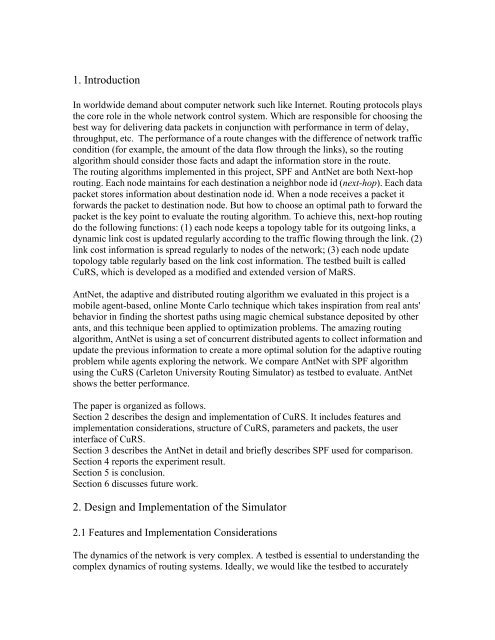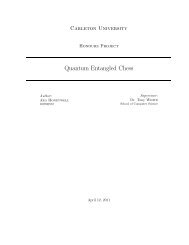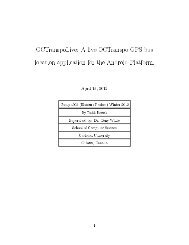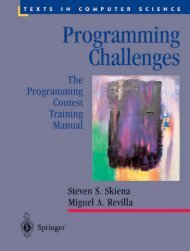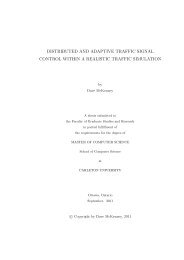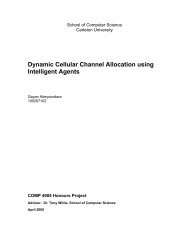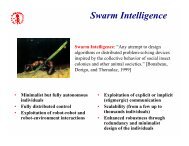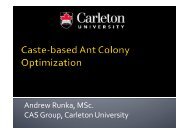Implement a simulator, in Java, for evaluating AntNet routing protocol
Implement a simulator, in Java, for evaluating AntNet routing protocol
Implement a simulator, in Java, for evaluating AntNet routing protocol
You also want an ePaper? Increase the reach of your titles
YUMPU automatically turns print PDFs into web optimized ePapers that Google loves.
1. IntroductionIn worldwide demand about computer network such like Internet. Rout<strong>in</strong>g <strong>protocol</strong>s playsthe core role <strong>in</strong> the whole network control system. Which are responsible <strong>for</strong> choos<strong>in</strong>g thebest way <strong>for</strong> deliver<strong>in</strong>g data packets <strong>in</strong> conjunction with per<strong>for</strong>mance <strong>in</strong> term of delay,throughput, etc. The per<strong>for</strong>mance of a route changes with the difference of network trafficcondition (<strong>for</strong> example, the amount of the data flow through the l<strong>in</strong>ks), so the rout<strong>in</strong>galgorithm should consider those facts and adapt the <strong>in</strong><strong>for</strong>mation store <strong>in</strong> the route.The rout<strong>in</strong>g algorithms implemented <strong>in</strong> this project, SPF and <strong>AntNet</strong> are both Next-hoprout<strong>in</strong>g. Each node ma<strong>in</strong>ta<strong>in</strong>s <strong>for</strong> each dest<strong>in</strong>ation a neighbor node id (next-hop). Each datapacket stores <strong>in</strong><strong>for</strong>mation about dest<strong>in</strong>ation node id. When a node receives a packet it<strong>for</strong>wards the packet to dest<strong>in</strong>ation node. But how to choose an optimal path to <strong>for</strong>ward thepacket is the key po<strong>in</strong>t to evaluate the rout<strong>in</strong>g algorithm. To achieve this, next-hop rout<strong>in</strong>gdo the follow<strong>in</strong>g functions: (1) each node keeps a topology table <strong>for</strong> its outgo<strong>in</strong>g l<strong>in</strong>ks, adynamic l<strong>in</strong>k cost is updated regularly accord<strong>in</strong>g to the traffic flow<strong>in</strong>g through the l<strong>in</strong>k. (2)l<strong>in</strong>k cost <strong>in</strong><strong>for</strong>mation is spread regularly to nodes of the network; (3) each node updatetopology table regularly based on the l<strong>in</strong>k cost <strong>in</strong><strong>for</strong>mation. The testbed built is calledCuRS, which is developed as a modified and extended version of MaRS.<strong>AntNet</strong>, the adaptive and distributed rout<strong>in</strong>g algorithm we evaluated <strong>in</strong> this project is amobile agent-based, onl<strong>in</strong>e Monte Carlo technique which takes <strong>in</strong>spiration from real ants'behavior <strong>in</strong> f<strong>in</strong>d<strong>in</strong>g the shortest paths us<strong>in</strong>g magic chemical substance deposited by otherants, and this technique been applied to optimization problems. The amaz<strong>in</strong>g rout<strong>in</strong>galgorithm, <strong>AntNet</strong> is us<strong>in</strong>g a set of concurrent distributed agents to collect <strong>in</strong><strong>for</strong>mation andupdate the previous <strong>in</strong><strong>for</strong>mation to create a more optimal solution <strong>for</strong> the adaptive rout<strong>in</strong>gproblem while agents explor<strong>in</strong>g the network. We compare <strong>AntNet</strong> with SPF algorithmus<strong>in</strong>g the CuRS (Carleton University Rout<strong>in</strong>g Simulator) as testbed to evaluate. <strong>AntNet</strong>shows the better per<strong>for</strong>mance.The paper is organized as follows.Section 2 describes the design and implementation of CuRS. It <strong>in</strong>cludes features andimplementation considerations, structure of CuRS, parameters and packets, the user<strong>in</strong>terface of CuRS.Section 3 describes the <strong>AntNet</strong> <strong>in</strong> detail and briefly describes SPF used <strong>for</strong> comparison.Section 4 reports the experiment result.Section 5 is conclusion.Section 6 discusses future work.2. Design and <strong>Implement</strong>ation of the Simulator2.1 Features and <strong>Implement</strong>ation ConsiderationsThe dynamics of the network is very complex. A testbed is essential to understand<strong>in</strong>g thecomplex dynamics of rout<strong>in</strong>g systems. Ideally, we would like the testbed to accurately


